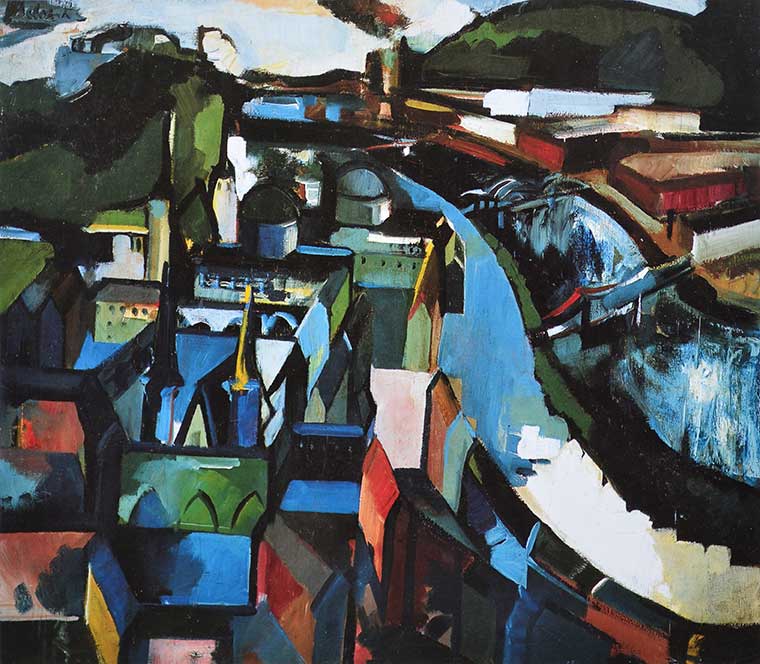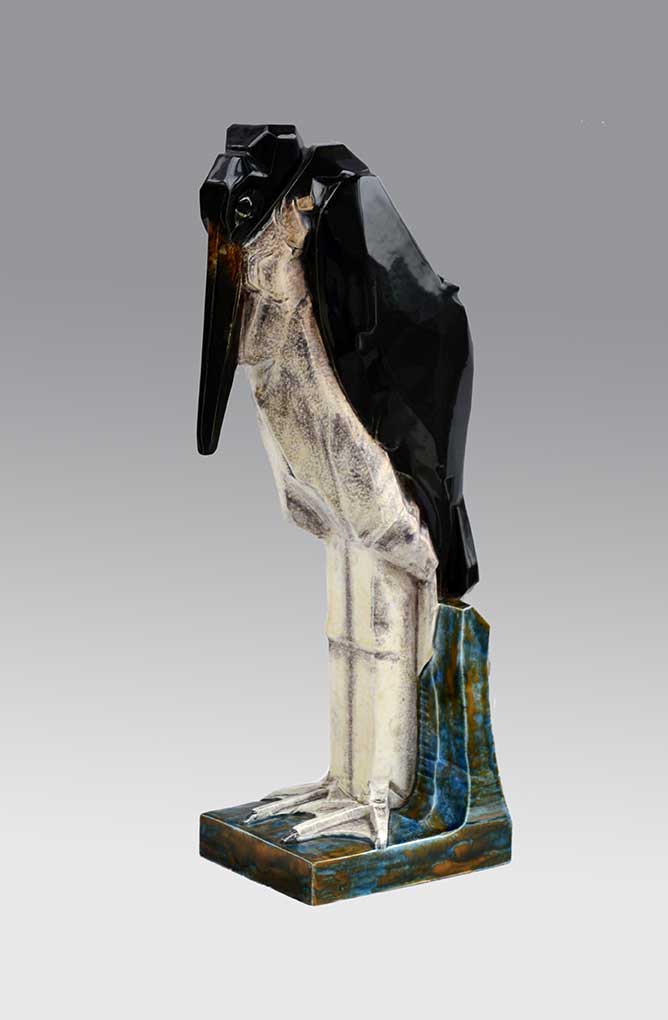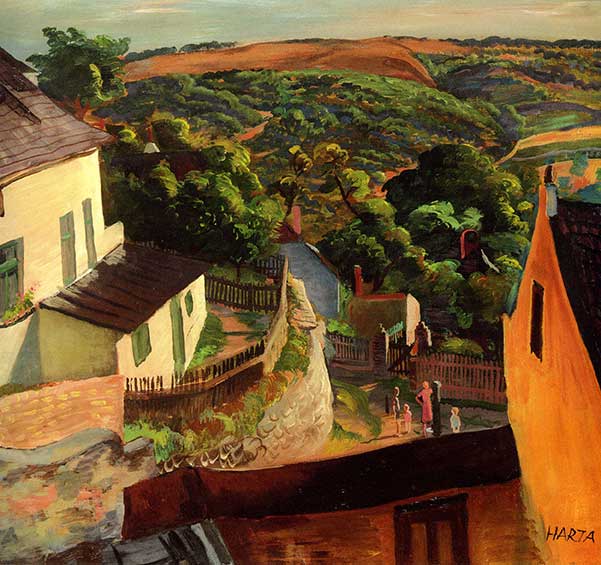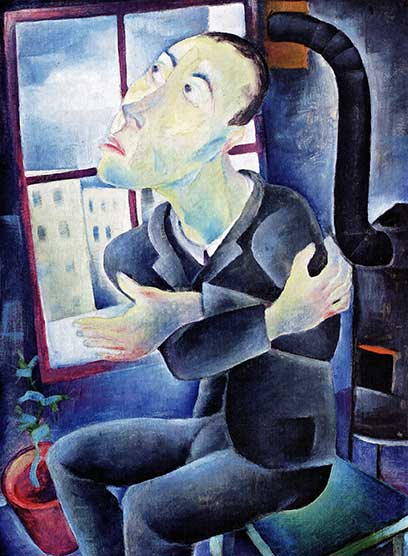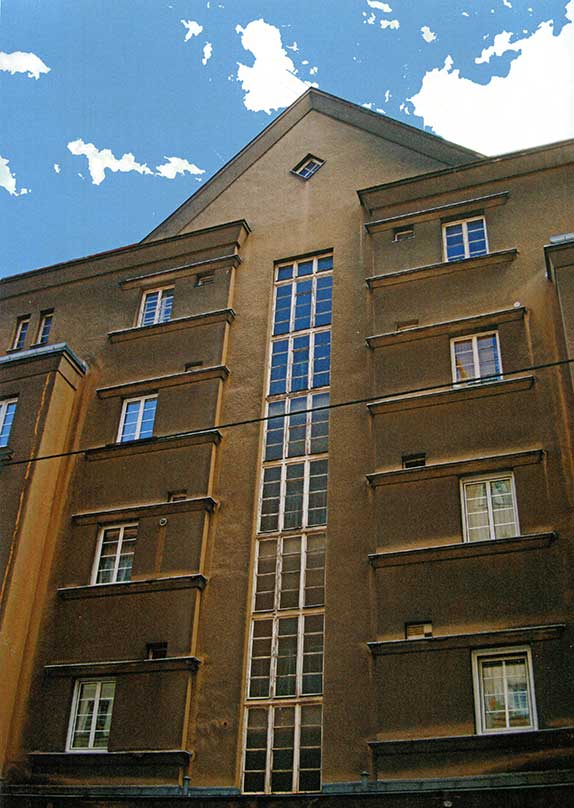FRIENDS OF THE HAGENBUND
VEREIN DER FREUNDE UND DER WISSENSCHAFTLICHEN ERFORSCHUNG DES HAGENBUNDES
The Verein der Freunde und der wissenschaftlichen Erforschung des Hagenbundes, or Friends of the Hagenbund for short, was founded in Vienna in 2002. Collectors of Hagenbund art had met, mostly by accident, over the years in galleries and museums. The individual collectors came together to form a circle of friends, united not only by their collecting passion but also by their desire to find out more about the association that had produced the works they so admired. The articles of association therefore include the following aims:
Aims
- Research into the fate of the Hagenbund and its members
- Positioning of the Hagenbund within the contemporary art scene from 1900 to 1938
- Awareness-raising through exhibitions and catalogues
- Publication of monographs and books
- Media work
The results of the collection and research activities of the Friends of the Hagenbund have been presented in several public exhibitions.

Exhibitions
- Künstler des Hagenbundes: 10. Sonderausstellung des Anton Hanak-Museums Langenzersdorf, May - November 1989
- Unbekannte Schätze - Klassische Moderne aus zehn Wiener Privatsammlungen. Ausstellung Schloss Rosenau 1998
- Moderne Tradition - Künstler des Hagenbundes und ihre tschechischen Gäste - Werke aus acht Privatsammlungen. Ausstellung Palais Kinsky Vienna July/August2002
- Die Künstlervereinigung HAGENBUND - eine Auslese. Ausstellung Museum ‚Alte Hofmühle’ Hollabrunn September/October 2005
- Sechs Ungarn im Hagenbund. Ausstellung mit Kunstwerken aus österreichischen Privatsammlungen und der ungarischen Nationalgalerie. Collegium Hungaricum Wien January/February 2015
Catalogues have been published to accompany the exhibitions.

Other activities
The forty years of research on 180 Hagenbund artists culminated in 2016 in an encyclopaedic
work by Peter Chrastek and Peter Sroubek:
HAGENBUND AND ITS ARTISTS: Expressionism, New Objectivity, Prohibition, edited by Wien
Museum and der Verein der Freunde und der wissenschaftlichen Erforschung des
Hagenbundes, exh. cat.. Wien Museum (Vienna 2016), ISBN-13: 978-3950405910, in German
and English.
It includes some hitherto missing biographical data and information about the fate of the
members from 1900 to 1938. The biographies of Hagenbund members, characterized by
economic hardship and political persecution, reflect how difficult it must have been to create art
during this time.

TV film commissioned by the Hagenbundfreunde
A documentary commissioned by our association and realized by PopUp Media Film- & TV-Produktion DER HAGENBUND - DIE VERLORENE MODERNE was broadcast on April 26, 2022 by ORFIII in the 'Erbe Österreich' series. The film aims to bring 'our' artist association out of the shadow of the Künstlerhaus and Secession and to make it known to a wider audience. The presentation of selected locations with works by Hagenbund artists in public space forms the common thread for a mixture of statements by well-known art experts.
The Hagenbund - The Lost Modern Age
Executive board
Prof. Peter Chrastek, initiator and after Dr. Kurt Berger and Dipl.Ing. Erich Gusel, third president in the history of the association, announced his resignation at the general meeting on November 29, 2019 and was named honorary president for his merits. Founding member Peter Sroubek was elected as his successor. Overall, the association is now represented by the following persons:

HAGENBUND
HAGENBUND ARTISTS’ ASSOCIATION
 The origins of the Hagenbund artists’ association in Vienna date back to the informal meetings of
artists to discuss contemporary visual arts from 1880 onwards. These gatherings took place
initially in various restaurants and then on a more regular basis in the restaurant Zum Blauen
Freihaus in Gumpendorfer Strasse, whose owner Josef Haagen gave the association its name.
The Künstlerbund Hagen der Genossenschaft Bildender Künstler Wiens was formally
established on 3 February 1900. At the outset, it was an association within the Genossenschaft
der bildenden Künstler Wiens (“Künstlerhaus”), established in 1861, the professional body
representing Viennese artists, sculptors and architects. Just as the Klimt group had left the
Künstlerhaus in 1897, the Hagenbund members also withdrew from its protection on 29
November 1900 following various disagreements. As the Künstlerhaus, which had opened in
1868, was no longer available for exhibitions, a new venue in the Markthalle in Zedlitzgasse was
established. The restructuring of this hall was organized by the architect Josef Urban, founder
member of the Hagenbund, who also worked as a theatre set designer, but already emigrated to
the USA in 1911. The exhibitions in Zedlitzhalle reflected the ambitious aims of the Hagenbund
and were devoted to the entire spectrum of visual arts, including applied and commercial art.
The origins of the Hagenbund artists’ association in Vienna date back to the informal meetings of
artists to discuss contemporary visual arts from 1880 onwards. These gatherings took place
initially in various restaurants and then on a more regular basis in the restaurant Zum Blauen
Freihaus in Gumpendorfer Strasse, whose owner Josef Haagen gave the association its name.
The Künstlerbund Hagen der Genossenschaft Bildender Künstler Wiens was formally
established on 3 February 1900. At the outset, it was an association within the Genossenschaft
der bildenden Künstler Wiens (“Künstlerhaus”), established in 1861, the professional body
representing Viennese artists, sculptors and architects. Just as the Klimt group had left the
Künstlerhaus in 1897, the Hagenbund members also withdrew from its protection on 29
November 1900 following various disagreements. As the Künstlerhaus, which had opened in
1868, was no longer available for exhibitions, a new venue in the Markthalle in Zedlitzgasse was
established. The restructuring of this hall was organized by the architect Josef Urban, founder
member of the Hagenbund, who also worked as a theatre set designer, but already emigrated to
the USA in 1911. The exhibitions in Zedlitzhalle reflected the ambitious aims of the Hagenbund
and were devoted to the entire spectrum of visual arts, including applied and commercial art.
Guests from Austria and other countries were regular contributors to the exhibitions. Oskar Kokoschka’s expressive oil paintings were shown as early as 1911, creating something of a sensation in the city, but also giving rise to angry protests. The short-lived Neukunst group headed by Egon Schiele, who had left the Academy of Fine Arts in Vienna in 1912, was invited to hold an exhibition that included works by Schiele, Gütersloh, Kolig, Wiegele and others. The Hagenbund was thus always open to and interested in foreign art and new artists, an interest that became more intense in the interwar years. Disapproving bodies forced the closure of the Zedlitzhalle from autumn 1912 and during the First World War, and the premises, in urgent need of renovation, could not be used again until 1919. Whereas traditional art had been the focus hitherto, after the war a younger generation of artists – names like Floch, Hauser, Lerch, Mayer- Marton, Merkel, Schatz or Schwarz-Waldegg – began to set new standards. The modern styles of Expressionism and New Objectivity became increasingly prominent, giving rise to a distinctive Hagenbund style.
From 1924 onwards, women were also permitted to join the association as extraordinary
members. They were not allowed to vote but could participate in the discussions and exhibitions.
The world economic crisis had a considerable impact on the Hagenbund and its members,
especially after 1929, since it made the sale of works of art increasingly difficult. With the
changing political circumstances in the 1930s, the characteristically tolerant and pacifist attitudes
of the Hagenbund became less and less desirable. Jewish members were expelled in February
1938 by president Karl Stemolak, apparently at the instigation of Leopold Blauensteiner,
responsible for visual arts in the Nazi Party Landeskulturamt (Provincial Department of Culture)
(1). The Hagenbund was ultimately dissolved after the “Anschluss” for both organizational and
economic reasons, the new legislation calling for its structure and assets to be transferred to a
(Nazi) “society of fine artists” (2). Some members were able to continue working under difficult
circumstances abroad; others were unable to escape and, like Fritz Schwarz-Waldegg or Robert
Kohl, were killed in concentration camps.
 The attempt to revive the Hagenbund after the war was
short-lived and unsuccessful.
The attempt to revive the Hagenbund after the war was
short-lived and unsuccessful.
From today’s perspective, the Hagenbund may be seen above all as a powerful interwar art
movement, occupying a distinctive and progressive place next to the Secession and
Künstlerhaus groups and notable for its cosmopolitan, heterogeneous and innovative character.
Many of its members were persecuted, driven out or murdered in concentration camps during the
Nazi era on account of their “non-Aryan” origins and/or their antifascist opinions. The
association’s archive was also completely destroyed. As the Hagenbund was extensively ignored
for a long time in the Austrian art and cultural scene, there was an evident gap between the
known and often high-quality works of art and the absence of biographical data about their
creators, which was asking to be closed. Hagenbund art is now increasingly recognized, but
there are still undiscovered treasures that make intensive research more worthwhile than ever.
Further information can be found under the Wikipedia entry for HAGENBUND
A list of members is provided
here.
Bernhard Denscher published an analysis of the exhibition posters as a visual self-portrayal of the artists' association.
(1) Lisa Frank: Meine Erinnerungen an den Hagenbund (New York 1993). In: Die verlorene Moderne – Der Künstlerbund Hagen 1900 – 1938. Österreichische Galerie im Schloß Halbturn, Burgenland, Vienna 1993.
(2) Ernst Ploil. “Das Ende des Hagenbundes” in Peter Chrastek, Hagenbund and Its Artists:
Expressionism, New Objectivity and Prohibition, eds. Wien Museum and Verein der Freunde und
der wissenschaftlichen Erforschung des Hagenbundes, exh. cat. Wien Museum, Vienna 2016, in
German and English.
CLOSELY OBSERVED
Friends of the Hagenbund present individual works
Viktor Planckh (Troppau/Opava 1904 – Athen 1941)
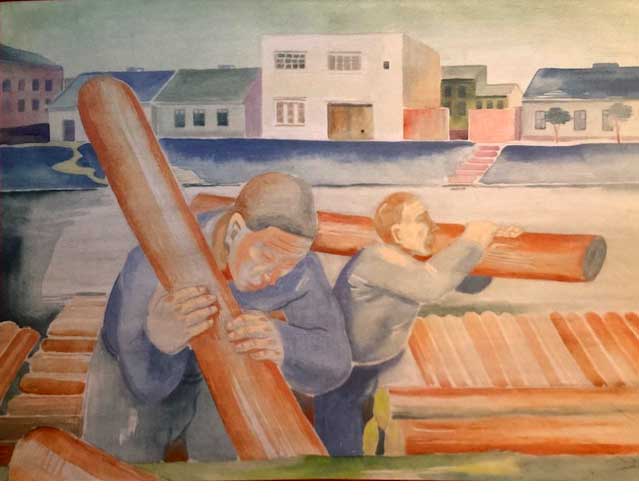

Raftsmen (above)
Gouache on paper 31 x 38 cm
Late autumn (below)
Gouache on paper 31 x 38 cm
Viktor Planckh,
Born in 1904 in Troppau/Silesia (now Opava/Czech Republic), at the age of 17, after his family moved to Vienna, he studied painting at the Vienna School of Applied Arts under Berthold Löffler and Franz Cizek, among others. He completed his studies in 1926. Between 1927 and 1938, he was a member of the Hagenbund (Hagenbund) and participated in numerous exhibitions. He was successful as a painter; his sculptures in terracotta and bronze are less well known. Planckh was also interested in frescoes and exhibited in Salzburg. After the dissolution of the Hagenbund, he was forced to join the Reich Chamber of Fine Arts to continue his career.
Several works on paper by Planckh have survived, two of which are depicted here. Both exude calm and simplicity; a magical, deserted silence reigns in 'late autumn.' A date is missing. Clarity, reduced forms, and a certain distance from the viewer are characteristic of New Objectivity works. Calmness and distance also prevail in Planckh's large oil paintings. Several such paintings are preserved in the collection of the Austrian National Bank. Planckh died of dysentery in Athens in 1941 while serving in the military.
Manfred Götz
ARCHIV
(last published)
Otto Rudolf Schatz (1900-1961)

Stimme der Arbeit (voice of work)
Woodcut
Otto Rudolf Schatz
was a versatile artist, at home in different styles and techniques. The illustrated new-objective woodcut from 1928 is one of several in the large-format book 'Stimme der Arbeit', a poem by Ernst Preczang. Born near Hamburg in 1870, Preczang was a trained book printer, was interested in the labor movement and was a co-founder of the Gutenberg Book Guild, which he left again in 1927. In 1933 he emigrated from Germany and went to Switzerland, where he died in 1949. The poem had already been published twice under a different name in 1916. For 1929 the Buchergilde Gutenberg prepared a deluxe bibliophile edition, for which Preczang made changes to the text and gave the title 'Voice of Work'. Schatz cut the text in wood and expanded the work with ten woodcuts. For presumably economic reasons, it was not printed and the book only appeared in 1999 on the initiative of Prof. Wilfried Daim with the support of the Lower Austrian Documentation Center for Modern Art. Daim has added a very informative afterword to the edition now available.
Manfred Götz
Franz lerch (1895-1977)

Still life with fish and candle
Oil / canvas, 60 x 70 cm. (signed lower right)
Franz Lerch
was born on August 30, 1895 in Vienna. The landscape, genre and portrait painter studied from 1919 to 1927 under Josef Jungwirth, Karl Sterrer and Alois Delug at the Vienna Academy. In 1927 he undertook study trips to Paris and Holland. Franz Lerch was able to make a living from his job from 1931 thanks to numerous prizes and purchases of his works by Austrian museums. He received i.a. the Prize of the City of Vienna and four times the State Prize. From 1927 to 1938 Franz Lerch was a member of the Hagenbund, and in 1946 he joined the Vienna Secession. Forced to emigrate because his wife was Jewish, Franz Lerch had been working in New York since 1938. In 1939/40 he destroyed many of his paintings.
Lerch's pictures have a rich colourfulness, great spatial depth and strong plasticity. References to the New Objectivity can be seen in the still life shown. Franz Lerch died on January 25, 1977 in New York
LOIS PREGARTBAUER (1899-1971)

Lower Austrian village landscape 1935/36
Pastel, 31 x 47 cm.
was one of the most active members in the Hagenbund in the 1930s. In addition to participating in numerous exhibitions, he designed several exhibition posters and was also active in the management of the association.
His stylistically diverse work was initially committed to the New Objectivity; in addition to city views, landscapes subsequently dominated, which soon earned him the attribute "Master of the pastel".
The illustrated work from 1935/36, which Pregartbauer dedicated to the art historian Fritz Grossmann, who was later forced to emigrate, is an excellent example of this. The subtle color surfaces of the landscape and sky create a bright, friendly atmosphere. This creates a clear contrast to his dark, often macabre subjects.
With the continuation of his life and work, in which he was associated with the Secession after 1945 (1957-1960 also as President) and most recently with the Künstlerhaus, the representational was reduced. These days, Pregartbauer's death is celebrating the fiftieth anniversary.
Manfred Pregartbauer, March 31, 2021
Archive (last published 2021)
Viktor TISCHLER

Old Port of Marseille 1928
Oil on canvas, 54 x 73 cm. shows his typical architectural and cubist expression. The restraint in color and the contrasting juxtaposition of walls and water are remarkable. The restraint in color and the contrasting juxtaposition of walls and water are remarkable.
Viktor TISCHLER (Painter and graphic artist),
born on June 26, 1890 in Vienna, died on February 24, 1951 in Bealieu-Mer / France.
- Landscapes, portraits and figures, some in a contemporary style
- 1920 – 1938 Member of the Hagenbund
- 1928 – 1941 he lived partly in Paris and southern France, then persecuted due to his Jewish origins and emigrated to the USA
- 1949 Return to the south of France
- Friends with Josef Floch and Franziska Zach
Andreas Grundbichler
Works by members of the Hagenbund placed in public
Numerous works by members of the Hagenbund are located in public spaces and will be presented here in a loose series. A comprehensive catalog of these numerous, often unknown works is currently being prepared, with particular emphasis on visual documentation.
FRANZ BARWIG d. Ä.(19. 4. 1868 – 15. 5. 1931 Wien)
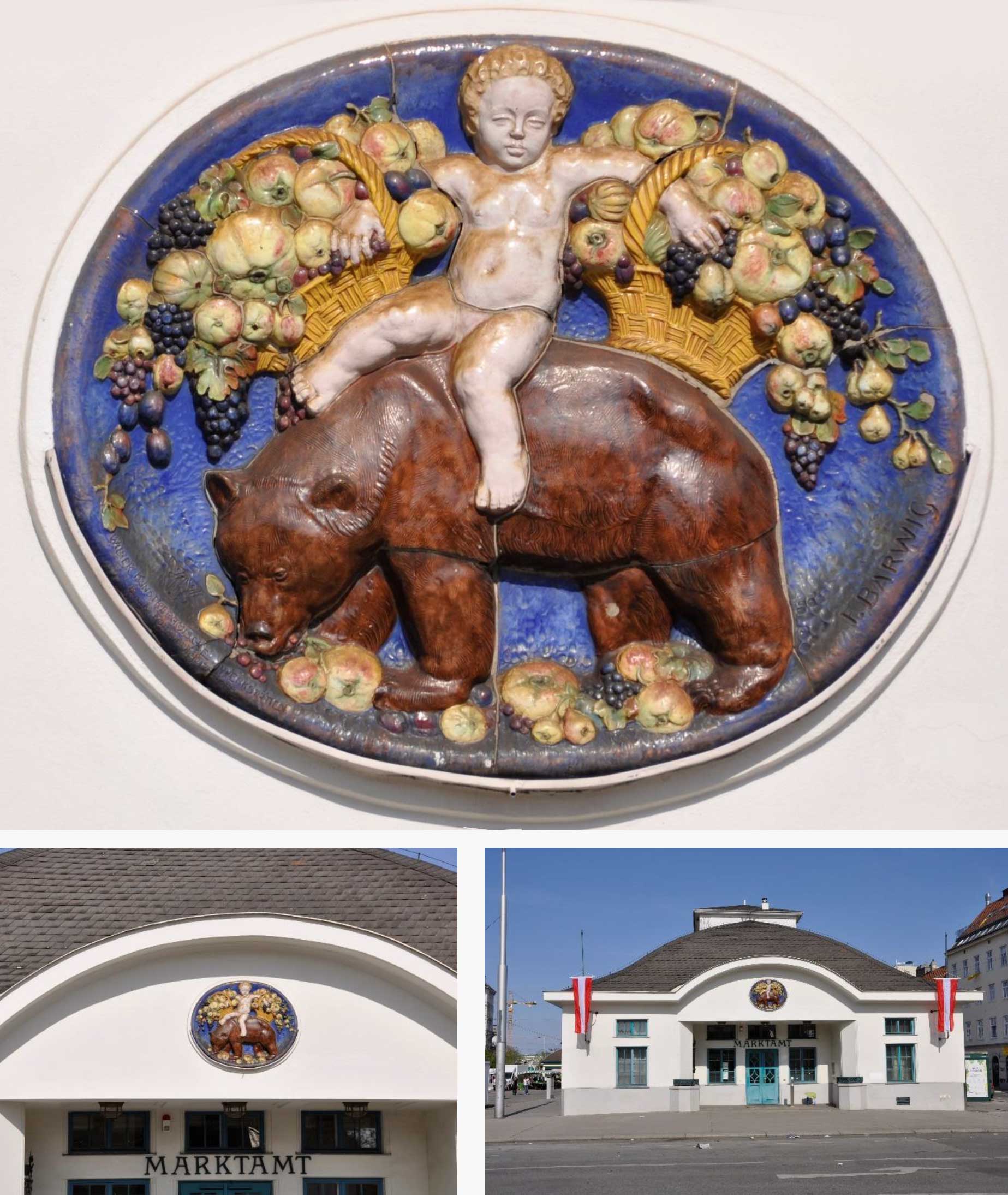
Putto Riding on a Bear, 1915/16
Signed: F. BARWIG (incised) / WKKW (signet) / WIENER KUNSTKERAMISCHE WERKSTÄTTEN / Imperial and Royal Kammerhefer
Majolica relief in the gable field on the front wall of the Market Office
Address: Corner of Rechte Wienzeile and Kettenbrückengasse, Naschmarkt, 1040 Vienna
The Market Office building was designed in 1915/16 by Friedrich Jäckel, a late historicist architect from the school of Karl König and Karl Mayreder at the Technical University. He was a member of the Vienna City Planning Office and also designed the Jörgerbad swimming pool in Vienna's 17th district, which opened in 1914. For the Market Office, he designed a freestanding pavilion with a distinctive bell-shaped roof. Prior to this, the "New Naschmarkt" was built according to his plans, consisting of 120 brick market stalls arranged in three rows, starting in 1910 after the Vienna River was vaulted. The entire complex was conceived to "structurally capture the Naschmarkt's own atmosphere" and preserve the "charm of Viennese fin-de-siècle."1 For this building, clearly planned in contrast to Otto Wagner's modern Art Nouveau houses in the immediate vicinity, Franz Barwig, professor of sculpture at the Vienna School of Applied Arts since 1910 and a member of the Hagenbund since 1905, created the faience in the form of a tondo with the motif of a putto riding a bear with filled fruit baskets. Barwig is recognized as one of the most important Art Nouveau woodcarvers, who combined a modern, blocky, Secessionist stylization with extremely accurate characterization and observation of animal creatures in his striking animal sculptures. Ludwig Hevesi, who appreciated Barwig's "wooden humor"2, and also Amelia Sarah Levetus in the magazine The Studio, have highlighted his precisely observed animal figures, which he carved directly from wood.3 He found inspiration for his modern formal language in a carving style that Hevesi described as "novel and interesting" in his works for the Hagenbund's 1908 spring exhibition, the Kaiserhuldigung,4 in ancient Egyptian art, among other sources. In a sculpture of a seated bear created in black granite in 1912/13, he achieved the effect of extreme physical tension that captivates the viewer's gaze through the rigid frontality and unity of the form with the suggestive formal substrate of graphic expression.5 Barwig also found inspiration in the formal language of the early Renaissance, as the comparison of the bronze figure of a boy 1908/096 with the figure of David by Donatello (around 1440) or that of Andrea del Verrocchio (1473/75) shows, whereby his reception of the ancient figurative ideal went through the German Art Nouveau artist Ludwig von Hofmann.7 The form of the tondo and the faience technique in the majolica relief also point to the engagement with the Florentine workshops of the Quattrocento, such as those of Luca and Andrea della Robbia. In the folk-style technique of twice-fired, tin-glazed stoneware, special color effects could be achieved through underglaze painting. The texture of the bear's fur appears just as realistic thanks to the drawn hatching as do the lush, polychrome fruits such as ripe apples, grapes, plums, and pears. The depictions of the compact, organic animal body in motion and the gaze of the feeding bear are also extremely convincing, pointing to Barwig's intensive studies at Schönbrunn Zoo, where he was a course instructor for nature studies of large animals in 1911.8 Barwig created the majolica relief in collaboration with the Viennese Kunstkeramischen Werkstätten Busch & Ludescher,9 where the twice-fired, color-painted, and glazed relief sculpture was manufactured and assembled in several parts. With its headquarters at Mollardgasse 39 (Vienna 1060), this company emerged from the A. Förster & Co. manufactory in 1908 and existed until 1930/31. It was deleted from the commercial register in 1940. From 1909 to 1915, they participated in the spring exhibitions of the Austrian Museum, in 1910 in the Brussels World's Fair, and in 1919 in the Austrian Arts and Crafts Exhibition.
FRANZ BARWIG the Elder
Born in Schönau near Neutitschein/Moravia (today: Šenov u Nového Jicina/Czech Republic) 19 April 1868 – 15 May 1931 Vienna
Sculptor of wood, stone, and bronze – initially naturalistic figures from folk life, later animal figures influenced by Art Nouveau, and after the First World War, clearer forms. In addition to portraits, he primarily created animal sculptures. Father of the sculptors Walter Barwig and Franz the Younger. From 1887 to 1893, he studied sculpture at the Vienna School of Applied Arts under H. Klotz. In 1900, he received a travel scholarship to Paris, where he met A. L. Barye. He designed and sometimes produced toy figures. From 1904 to 1906, he taught at the School of Woodworking in Villach (replacing his brother-in-law K. Widter, who had been appointed to the post). From 1906 to 1924, he taught at the Vienna School of Applied Arts, becoming a professor in 1910. Numerous visits to the Schönbrunn Zoo led to virtuoso animal depictions. Between 1915 and 1917 he created figurative works for the sets of operas in the Vienna Court Opera (e.g. for “Violanthe” and “Ariadne auf Naxos”). In 1904 he was represented for the first time in the Hagenbund, 1905–1924 a member of the Hagenbund, also a member of the Kunstschau, the Austrian and German Werkbund, and from 1925 of the Vienna Secession. In 1908 he played a key role in the anniversary procession designed by Joseph Urban to mark the 60th anniversary of the reign of Emperor Franz Joseph. From 1925 to 1927 he spent time in Florida, USA, where he was commissioned by Joseph Urban to create the sculptural decorations for the Hutton family’s Mar-a-Lago country estate (animal sculptures, a fountain, and reliefs – together with his son Walter). After his return he could no longer find his way in the local art scene and suffered from depression. He eventually committed suicide. Exhibitions include: 1907 Venice Biennale, 1925 Vienna Secession, 1931 Vienna Secession Memorial Exhibition (119th exhibition), as well as in numerous cities in Europe and New York. Works have been exhibited at the Belvedere, the Vienna Museum, the Albertina, the Hungarian National Gallery in Budapest, the Museum of Applied Arts in Vienna, and Lower Austria, among others. State Museum, Modern Gallery Prague, Galleria Nazionale d’Arte Moderna Rome, but also in churches (1916 Christmas crib in the deanery church in Tulln, 1918 Madonna and Child/linden wood in the parish church of St. Othmar in Vienna) and in public (1918 “The Youth” in Vienna’s 13th district, Haydn Park, 1927 bronze figure of a youth, after being installed in the “Reumannhof” and the “Rabenhof” now in the collection of the Vienna Museum, 1928/29 two wooden monkey figures in the monkey house in the Schönbrunn Zoo), furthermore war memorials in the district of Lower Austria.
Cornelia Cabuk
GEORG EHRLICH (Vienna 22. 2. 1897 – 1. 7. 1966 Ascona)
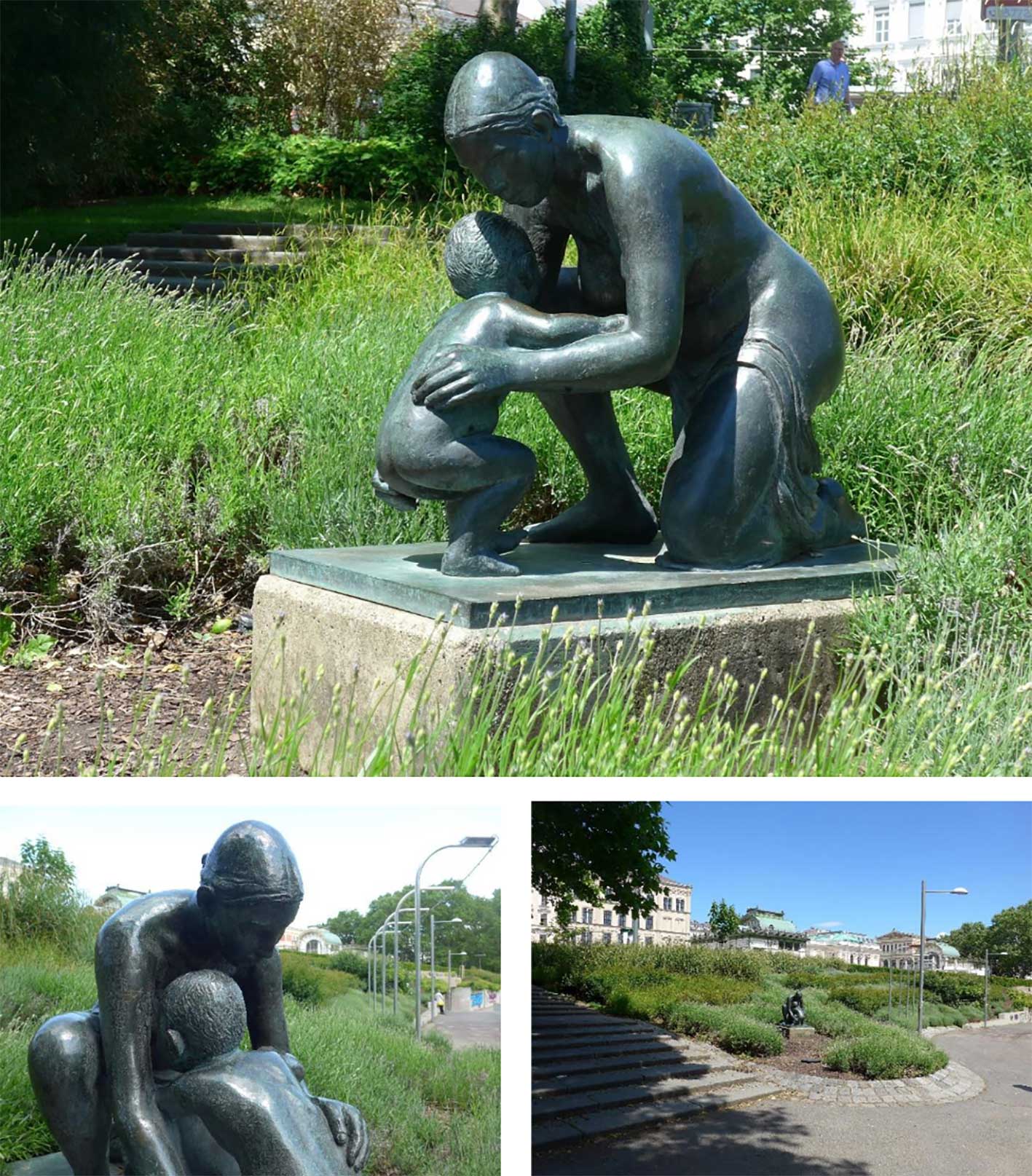
Kneeling Mother with Child, 1932, signed and dated: G. EHRLICH 1932 I/V (carved), bronze, 83 x 107 x 58.5 cm
Address: Karlsplatz, Resselpark, 1010 Vienna
Originally intended for a fountain, the sculpture consists of two figures on a pedestal: the kneeling mother with her upper body bent forward and the infant, who, in a squatting position, is facing her. This grouping creates the closed effect of the ensemble surrounding a hollow space. However, documentary photographs from the creation phase show that Ehrlich originally designed the composition differently. The mother leans protectively over the child, who moves away from her in a tentative forward movement. During these first attempts at walking, the child's upper body assumes a position aligned with that of the mother. The expression in the extremely sensitive depiction of both bodies was enhanced by the parallelism of the movement. The spiritual internalization that was characteristic of Ehrlich's early drawings and prints was also formally transferred into the medium of sculpture in the fine drawing of the two heads, their subtly described facial expressions, and the differentiated hairstyles. The contrast is particularly striking in the mother's wavy strands, tied in a knot at the nape of her neck, and the child's delicately curled head of hair. The photograph by Trude Fleischmann in the Wien Museum, which shows him at work, was inscribed on the back by his widow, the painter Betina Ehrlich-Bauer, an extraordinary member of the Hagenbund until 1938: "To Hofrat / Dr. Robert Weissenberger, most cordially and gratefully / dedicated by Bettina 1985 / Georg Ehrlich c. 1933 / in the "Ditteshof" Vienna / working on the group that / has stood in bronze at the / Karlsplatz (garden) since 1977 / the child was then turned over / Photo Trude Fleischmann."1 Ehrlich exhibited the plaster model in its current form in 1936 at the Neue Galerie in Vienna.2 Max Roden reviewed it: "The three are followed by the group "Mother and Child," intended for a fountain, distinctive in its posture, but also very careful to strictly adhere to compositional principles. Despite the heaviness inherent in the mother's body due to its position, lightness and grace can be found in the structure, and despite the separation of the figures, although they are related to a common basis, their connection is casually emphasized..“
It was only in the second half of the 1920s that Ehrlich turned to sculpture, creating, among other things, portrait busts of his friends and patrons Erica Tietze-Conrat (1927) and Hans Tietze (1931), in which, as the art historian Else Hofmann noted, he also created "austere grandeur" with "fine-nerved delicacy."4 In the bronze of an "Italian Boy" (1932), he achieved an exemplary combination of "soulfulness" and "classical form." For this, he received a gold medal in Paris in 1937. The pronounced spirituality of his early Bible cycle (1920), influenced by the experiences of the First World War, and the sensitivity of his fine-lined drawings, such as those of the actress Elisabeth Bergner and the expressionist dancer Niddy Impekoven, also characterize his sculptural work, in which he shaped a "new classicism" in line with the development of contemporary art in Europe.
GEORG EHRLICH
Vienna 22. 2. 1897 – 1. 7. 1966 Ascona
Sculptor, graphic artist, and painter – Until around 1926, he processed his war experiences through expressive drawings, lithographs (including the 1921 Bible cycle), and etchings. From 1926 onward, he turned to sculpture, producing predominantly portraits, figures, and, especially in his English exile, animal depictions, all mostly in classically harmonious lines. The artist painted only a few oil paintings (figure paintings, landscapes) (around 1927–1933), but always produced drawings and sketches for sculptural works, as well as landscape watercolors from the late 1920s onward. From 1912 to 1915, he studied at the Vienna School of Applied Arts under O. Strnad and F. Cizek. From 1916 to 1918, he served on the Russian and Italian fronts. He exhibited his works for the first time in 1919 at the "Neue Bewegung" art association in Vienna. From 1920 to 1924, he lived in Munich and Berlin, exhibited with artists such as E. Barlach, M. Beckmann, P. Klee, O. Kokoschka, W. Lehmbruck, and M. Liebermann (he received a contract with P. Cassirer), and became a lifelong friend of E. Bergner. In 1924, he returned to Vienna. In 1921, he was a guest of the Hagenbund for the first time. From 1925 to 1938, he was a member of the Hagenbund. In 1930, he met the painter and graphic artist Bettina Bauer and married her the same year. Except for the period of World War II, the couple spent most summers in Grado, where the Bauer family owned a house. Before 1938, they also spent some time at Lake Wolfgang (Zinkenbacher Painters' Colony). In 1937, he emigrated to England, followed by his wife in 1938. In 1944, he was commissioned to create the PAX Peace Memorial to commemorate the victims of Coventry. In 1947, he became a British citizen. From 1947 to 1949, he lived in the USA, briefly teaching in Columbus, Ohio. From the early 1950s, he became friends with Benjamin Britten and Peter Pears, and created portrait sculptures. In 1965, he suffered a serious heart condition, and spent time in Italy and Ascona, where he died in a clinic. Ehrlich's works were exhibited in numerous countries around the world, including Austria, Germany, Switzerland, France, England, Belgium, the Netherlands, and the USA. He participated in the Venice Biennales in 1932, 1934, 1936, and 1958, and in the World Exhibition in Paris in 1937. Selection of portrait heads: E. Tietze-Conrat, H. Tietze, O. Laske, G. Wiesenthal, E. Bergner, G. Merkel, P. Pears, B. Britten, B. Bauer-Ehrlich. Works include the Belvedere, Albertina, Vienna Museum, British Museum London, Tate Gallery London, Metropolitan Museum New York, and the Royal Museum of Fine Arts Antwerp.
Cornelia Cabuk
GEORG EHRLICH (Vienna, February 22, 1897 – July 1, 1966, Ascona)
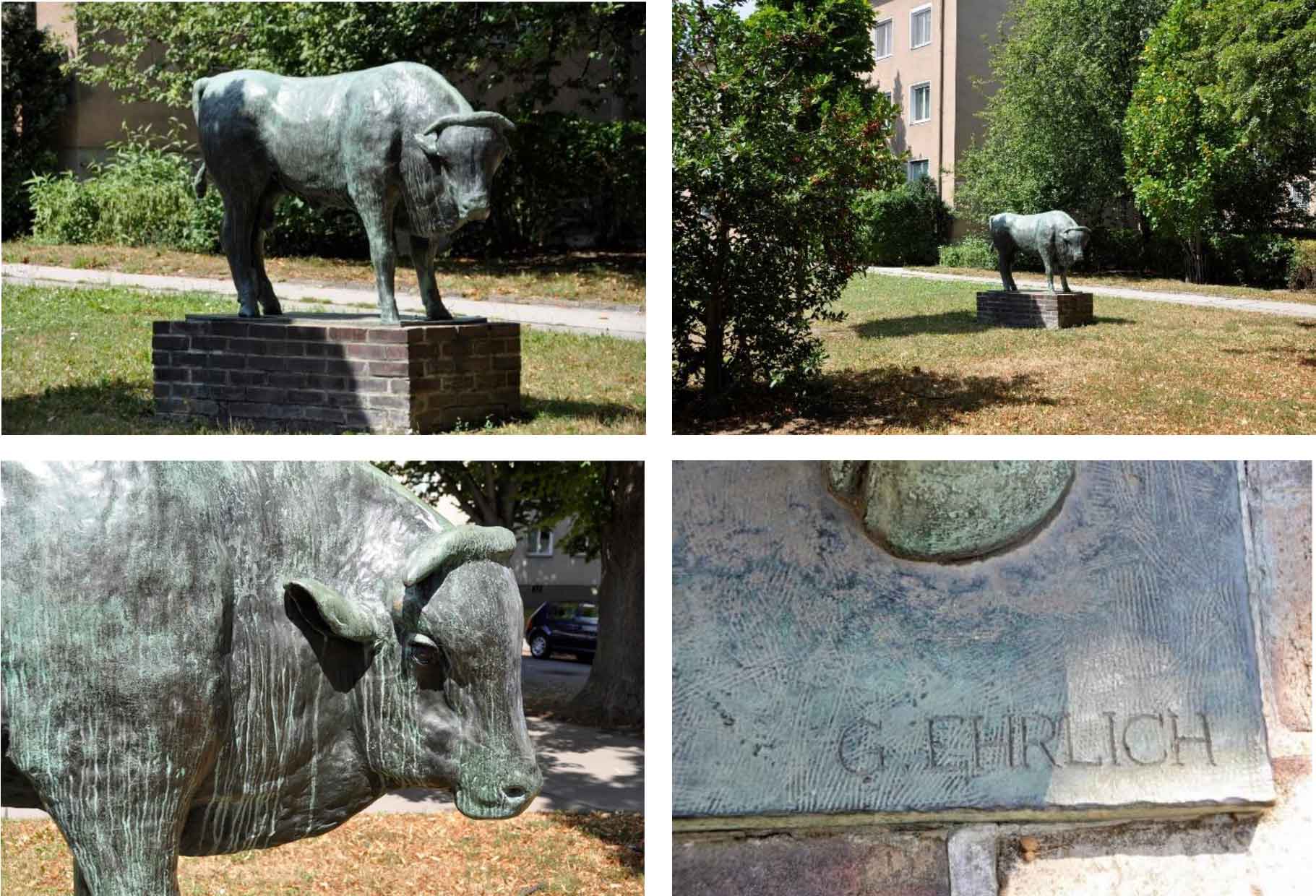
Large standing bull, 1959
Sign. und dat.: G. EHRLICH, Bronzeplastik auf Ziegelsockel
Signed and dated: G. EHRLICH, bronze sculpture on brick base
In 1959, Georg Ehrlich was commissioned by the City of Vienna to create the sculpture "Large Standing Bull," which has been in its current location near the kindergarten of the "Helmut Qualtinger Hof" since 1960/61.1 His “Large Bull Torso” with the motif of the characteristic bull’s head in natural size with the powerful neck down to the front legs (H 140 cm) was exhibited in 1962 at the Academy of Fine Arts in Vienna as part of a solo exhibition with sculptures and graphics.2 During this time, he received numerous honors from the City of Vienna: In 1960, he was awarded the title of professor, and in 1961, the city awarded him another commission for the bronze "Duet" at the Theater an der Wien. In the same year, he was awarded the Honorary Prize. The "Large Standing Bull" was originally intended for a residential complex on Pirkebnerstrasse in the 12th district; a model from 1959 was depicted in the brochure "The City of Vienna as Patron III."3 Possibly due to the proximity of the planned site to the Wienerberger brick factory, the brick base was chosen, which reinforced the impression of power and defense in the standing bull. Art played a significant role in Vienna's social urban development, based on the conviction that "the artist cares about his time and his environment so that the inhabitants of this city can recognize and affirm themselves in the artistic creation."4 The installation of the bull sculpture at the kindergarten in Paradisgasse connects the two central themes relevant to Ehrlich: children and animals. Ehrlich, whose works in public collections in Germany were confiscated and destroyed as "degenerate" in 1937,5fled from Vienna to London after his participation in the Paris World's Fair and the 74th Hagenbund Exhibition in the same year, where he increasingly devoted himself to animal sculpture. He chose domesticated animals such as pigs, cows, dogs, goats, and deer as motifs for his bronze sculptures. The reality of two world wars and exile prompted Ehrlich's artistic inquiry into the elemental nature of humans and animals. Ehrlich's longtime friend, the art historian Erica Tietze-Conrat, commented on this new phase of his work in 1956: "In a disturbed state of mind rooted in the experience of two world wars, he stretched natural truth to its extreme by subordinating it to expression. Now Ehrlich once again seeks the path to nature."6 His interest in the animal world, however, began in early childhood: "Even as a small boy in Vienna, I often walked the long way from my parents' apartment to the Schottentor with my sketchbook to draw cab horses. […] In one of my sketchbooks at that time, I wrote: 'If you draw a grazing horse, you must be a grazing horse yourself.' Only now, at a mature age, have I depicted the cab horse of my childhood in bronze. […] With humans and animals, it is important to me to capture the essential and commonalities from the multitude of individuals I observe."7 Tietze-Conrat described this search for the original form: "Not that his cow is ever just the neighbor's cow; it is THE COW, the image of the cow distilled from dozens of individual cows, the cow as such."8 Ehrlich's bull sculpture is emblematic due to the ideal, classical form of its naturalistic depiction. Detailed, graphic observations, based on the differentiated surface treatment of the head, neck, horns, and nostrils, are incorporated into the individual character. Ehrlich thus inscribed tactile details such as the folds of skin, the soft fur at the base of the horns, the movable ears, and the expressive eyes as significant reflections of the existential within the basic sculptural form that describes the essence.
1Georg Ehrlich. Sculptures and Drawings. 45th Special Exhibition of the Historical Museum of the City of Vienna, September 30–December 5, 1976, Timeline, pp. 11–12, here: 12; www.geschichtewiki.wien.gv.at/Georg_Ehrlich (Accessed: July 24, 2025).
2Georg Ehrlich. Sculptures and Graphics, exhibition of the Federal Ministry of Education, Academy of Fine Arts in Vienna, March 9–April 8, 1962, Cat. No. 1.
3The City of Vienna as Patron III, Vienna 1959, p. 83.
4Eduard Gaertner, "The City of Vienna as a Commissioner for Painters and Sculptors. The City as Patron," in: (see note 3), p. 9.
5Confiscation inventory of “degenerate art”, Free University of Berlin, 7 works by Ehrlich; website: emuseum.campus.fu-berlin.de
6„In the agitated state of mind caused by experiencing two wars he stretched the truth of Nature to the utmost, subordinating it to expression. Now Ehrlich is seeking the way to Nature again.” Erica Tietze-Conrat, Georg Ehrlich, London 1956. P. 21 (translation by the author).
7Georg Ehrlich, Sketchbook, New York 1962; quoted from: Antonia Hoerschelmann, Georg Ehrlich. Forms of Suffering and Joy, in: Georg Ehrlich. 388. Exhibition December 12, 1997–January 25, 1998, Albertina Prints and Drawings Collection, Vienna 1998, n.p.
8„Not that his cow is ever just the neighbour´s cow; it is THE COW, the image of the cow distilled from dozens of individual cows, the cow as such.” Tietze-Conrat (see note 9) p. 18 (translation by the author).
BÉNI FERENCZY (Szentendre/Hungary June 18, 1890 – June 2, 1967 Budapest/Hungary)
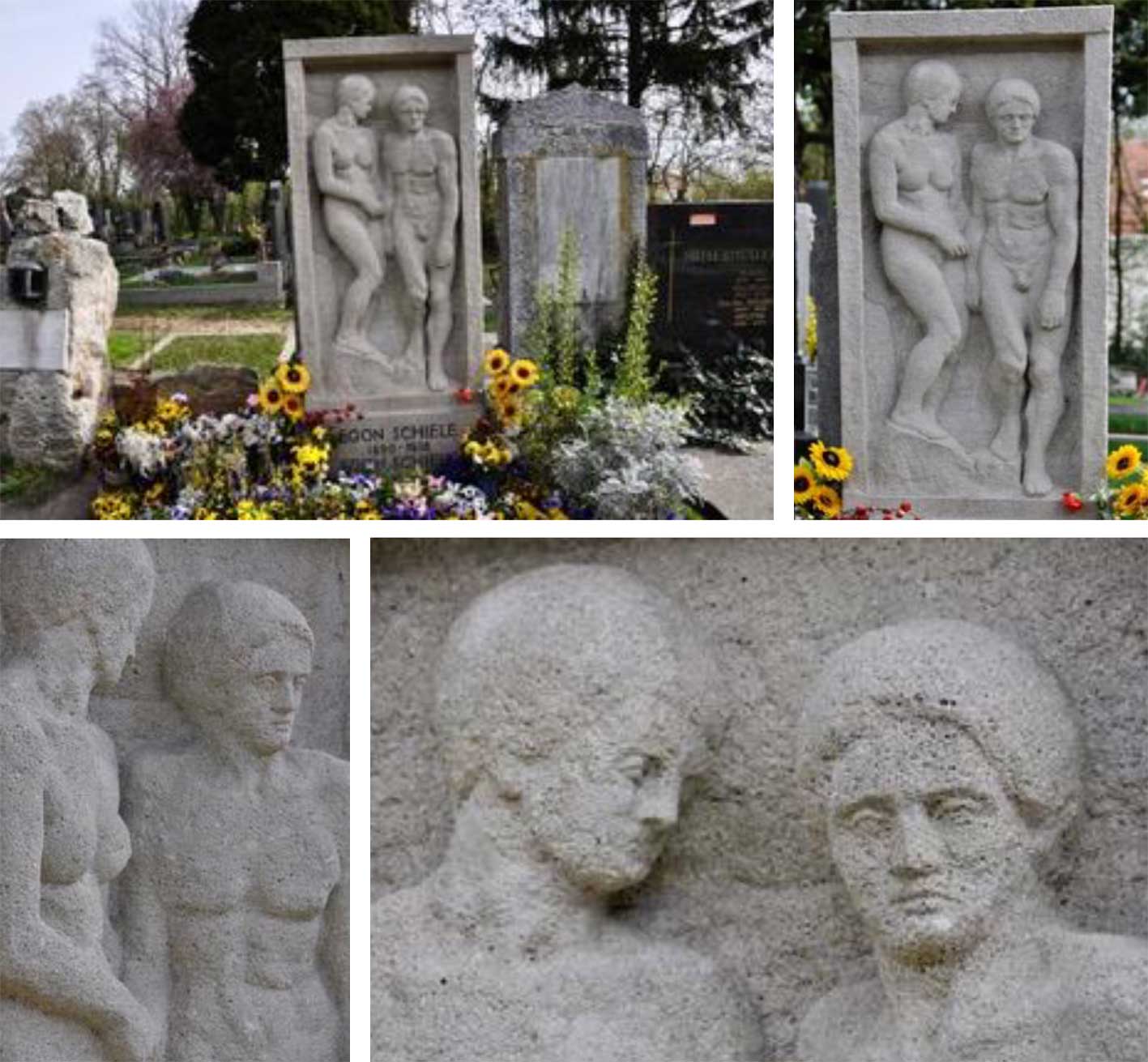
Egon Schiele's grave at the Ober Sankt Veit Cemetery, 1928/29
Address: Ober St. Veit Cemetery, Gemeindeberggasse 26, 1130 Vienna
On October 28, 1918, Egon Schiele buried his wife Edith in her father's grave at the Ober-St.-Veiter Cemetery. On his way back from the cemetery, he was struck by the fever of the Spanish flu. Three days later, on October 31, he too died at the age of just 28. His body was interred in the same grave on November 3. The cemetery had been chosen because the unhappy couple had last lived in Hietzing. Only a few years later did the City of Vienna allocate Egon and Edith Schiele an honorary grave in the same cemetery (Group B, Row 10, Numbers 15-16). In May 1928, the Vienna City Welfare Committee decided to take over the maintenance of Schiele's grave.
At the same time, the late painter's friends and admirers began raising money to finance the gravestone. The driving force behind this venture was the Society for the Promotion of Modern Art in Vienna, under its vice president Heinrich Benesch, who had already promoted and supported Schiele during his lifetime. It was also the Society that commissioned the Hungarian sculptor Béni Ferenczy for the limestone tombstone. It is still unclear whether this was a direct commission or a result of winning a competition. In any case, the Society decided in favor of Ferenczy's proposal based on some sketches submitted by him. One of these sketches is now in the "Stiftung Sammlung Kamm" (Kammer Collection Foundation) in Zug, Switzerland, and another is in the Ferenczy Museum in Szentendre, Hungary. In addition, Ferenczy was also commissioned to create an Egon Schiele Medal. Ferenczy received the sandstone block for the tombstone in March 1929 and presumably completed the work by mid-June of that year.
The two relief figures are typical of Ferenczy's nudes from this period. They are always very restrained and remain schematic. The figures indicate the deceased only through their age. Perhaps unconsciously, Ferenczy cited ancient models with his half-relief. In several newspaper reports published on the occasion of the gravestone unveiling, the relief is described: "The memorial stone is made of sandstone and depicts the symbolic figures of Egon Schiele and his wife. Both are walking downhill, the male figure with firm, energetic steps, the female a few steps back in soft devotion.
Another newspaper report states: "The larger-than-life work depicts in relief two figures, a male and a female, walking backward into the depths in pain-filled grief, the man with a firm, purposeful gaze, the woman more softly modeled in devotion."
The description of the gravestone in the "Wiener Zeitung" reads: "The grave monument depicts in relief a naked male figure who, followed by a female figure, appears to be slowly walking downwards. This is intended to commemorate the tragic end of Egon Schiele and his wife Edith." who, three days before her husband – on October 28, 1918 – fell victim to the flu epidemic raging in Vienna at the time."3
On the eve of the day of remembrance for all the dead, on October 31, 1929, Egon Schiele's gravestone was unveiled. Family members, friends of the deceased, and representatives of the Society for the Promotion of Modern Art gathered at the grave for the occasion. Heinrich Benesch, Vice President of the Society for the Promotion of Modern Art, was the first to speak. City Councilor Richter spoke as a representative of the City of Vienna before wreaths were laid on the grave by friends.
BÉNI (BENJAMIN) FERENCZY
Szentendre/Hungary June 18, 1890 – June 2, 1967 Budapest/Hungary
Sculptor, medalist, graphic artist, and illustrator – As a sculptor, he primarily created the human nude, and as a medalist, he created numerous portrait and commemorative medals. Both his father, Karoly, his mother, Olga (Fialka), and his siblings, Noemi and Valer, were visual artists. He received his first artistic instruction in 1907/08 in Nagybánya, Hungary (now Baia Mare, Romania) under Istvan Reti and Bely Ivanyi-Grünwald. He studied in Florence in 1908/09, and in Munich in 1909/10. Between 1911 and 1913, he spent two study visits to Paris (sometimes with his mother and sister), and had contacts with Bourdelle and Archipenko. He returned to Budapest in 1913, where he held his first exhibitions in 1914. In 1921, he moved to Vienna and became his permanent residence until 1932, interrupted only by two trips to Berlin in 1921/22 and 1922/23. From 1932 to 1935, he lived in Moscow, then returned to Vienna and stayed until 1938, then in Budapest.
From 1945 to 1949, he was a professor at the School of Applied Arts in Budapest. In 1928, he created the stone Egon Schiele tombstone at the Ober St. Veit Cemetery in Vienna and, in 1930, the stone relief "Fallhammer" at the former employment office for metalworkers in Embelgasse, Vienna-Margareten.
From 1927 to 1938, he was a member of the Hagenbund (Hagenbund), also a member of the Hungarian artists' association KUT. He exhibited in numerous countries, including the 1963 exhibition "Béni Ferenczy in the Circle of His Contemporaries" at the Vienna Künstlerhaus. Works include:
Belvedere, Albertina, Hungarian National Gallery Budapest, Ferenczy Museum Szentendre
and in public spaces throughout Hungary.
Markus Kristan
ROBERT ÖRLEY (Vienna 24.8.1876 – 15.11.1945 Vienna)
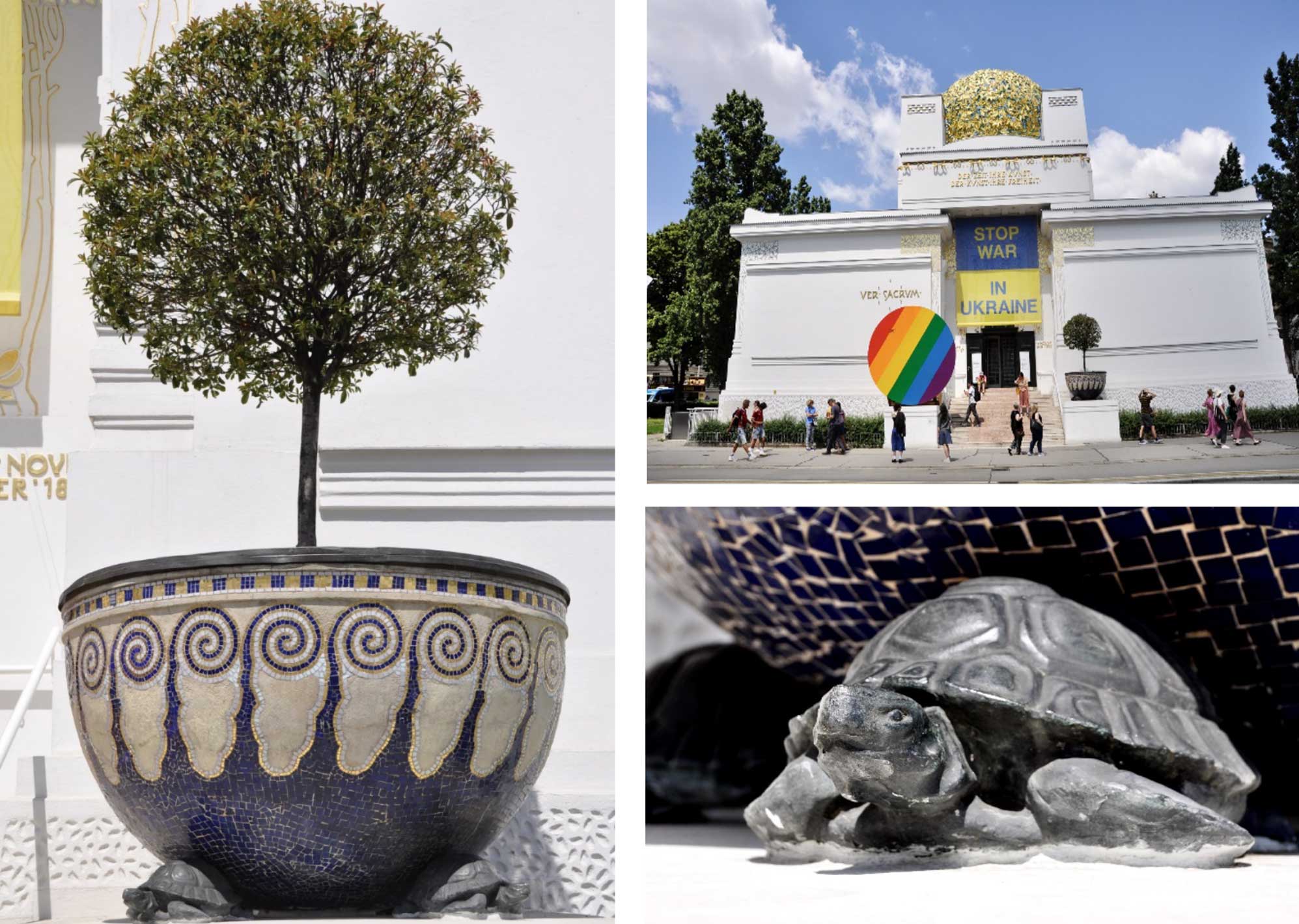
Two mosaic bowls, each with four turtles, in front of the Vienna Secession.
Address: Friedrichstraße 12, 1010 Vienna
When Robert Örley joined the Austrian Secession Association of Fine Artists in 1907, after having been a member of the Hagenbund since 1902, he was commissioned to carry out the first renovation of the Art Nouveau building erected by Joseph Maria Olbrich in 1898. Originally influenced by the Otto Wagner School, the architect, admired by Adolf Loos, was, along with Joseph August Lux, a supporter of the reform movement. Örley defended Loos's buildings, the Café Museum and his house for Goldman & Salatsch on Michaelerplatz, and was considered a core avant-garde artist without being an avant-gardist. As a protagonist of Viennese Modernism, he pursued a holistic spatial art in the spirit of the Gesamtkunstwerk, in which he gave renewed importance to the wall as a surface. He was a painter, graphic artist, and also a talented designer who, as early as 1900, had created Art Nouveau fabric designs, including those for the Vienna State Opera. in collaboration with Hagenbund member Heinrich Lefler for the firm Joh. Backhausen and Sons. During the renovation, Örley had the facade and the Secession building cleaned of Secessionist decorations and lettering, including the removal of the Secession motto formulated by Ludwig Hevesi. He commented on the change in his review of the 30th exhibition designed by Örley in 1908. After almost a year of inactivity, the "Association of Fine Artists of Austria," as it now predominantly calls itself, has opened its 30th exhibition. The building has been renewed inside and out, and all sorts of symbols and admonitions expressing the term Secession have disappeared. Various wall decorations originating from secessionist Secessionists have also been replaced by a more general white.
The two mosaic bowls were mentioned in the catalog as "Two vases in reinforced concrete with glass mosaic, executed by E. Gärtner, construction company, and Ignatz Dürr, glazier, Vienna VI." With them, Örley placed a distinct colorful accent on the two largely empty, white wall surfaces of the façade. With the motif of the turtle as world-bearer, originally from India, he reflected the character of the building as "a piece of the Orient in Vienna" emphasized by Hevesi in 1898 with the theme of the dome's laurel tree in the semicircular tree bowls, each with four metal-cast turtles, in the entrance area. Noteworthy in this context is Örley's typical execution in the then extremely modern material as "reinforced concrete bowls," whereby he transferred the archaic content into a contemporary formal language. His sense of modern design is evident in the mosaic's simple geometric spiral form, which, as an ornamental band, suggests a rotating movement opposite to that of the turtles. The design of the bowls is conceived holistically in the planting of topiary box trees. The immovable mosaic bowls are perceived as a permanent fixture in the entrance area, with their reduced color scheme of blue, gold, and white reinforcing the sacred, temple-like atmosphere of the building.
ÖRLEY ROBERT
Vienna 24.8.1876 – 15.11.1945 Vienna
Architect, artisan, painter, and graphic artist – As an architect, he primarily built residential buildings and factories, designed household goods, wallpaper, and fabric samples. As a painter, he created watercolor views and a series of lithographs of Vienna. He initially learned the carpentry trade and studied at the Vienna School of Applied Arts under K. Hrachowina and K. Minnigerode from 1891 to 1894. He spent 1896/1897 studying in Italy, and also traveled through France, England, Germany, and the Netherlands. Selected buildings: 1904/1905 family residence, Vienna 19, Weimarerstrasse 98; 1907 Paulick Residence, Vienna 18, Türkenschanzstrasse 23; 1907/1908 Luithlen Sanatorium, Vienna 8, Auerspergstrasse 9; 1917 Zeiss Optical Works, Vienna 16, Abbegasse 1;
1923/1925 Hanuschhof, Vienna 3, Lechnerstrasse/Dietrichgasse and Ludwig Kössler-Platz; 1927/1939
George Washington-Hof, Vienna 12, Untere Meidlinger-Strasse 1-12 (with K. Krist). From 1928 to 1932, he worked in
Turkey and completed numerous projects for the Turkish government. 1902 member of the Hagenbund,
1907 to 1939 member of the Vienna Secession (President 1912/1913), further memberships in the Austrian and German Werkbund, as well as the Central Association of Architects of Austria. He was also President of the Austrian Werkbund. Works include the Albertina, Vienna Museum. Örley died in 1945 from the injuries sustained in a car accident in front of the Secession building.
Cornelia Cabuk
ROBERT ÖRLEY (Contribution by Markus Kristan)

Sanatorium Luithlen, 1907/08 (1910 Renamed “Sanatorium Auersperg”; currently Hotel)
Adresse: Auerspergstraße 9, 1080 Wien
The former Luithlen Sanatorium in Vienna's Josefstadt district, significantly altered both inside and out, is a major work by Robert Örley and is considered one of the icons of Viennese architecture that emerged immediately after the turn of the 19th and 20th centuries.
The sanatorium was named after the Viennese dermatologist, Professor Dr. Friedrich Luithlen. In June 1907, the Ministry of the Interior granted him permission to establish a stock corporation under the name "Sanatorium Dr. Luithlen, Aktiengesellschaft." The company's inaugural general meeting took place on June 22, 1907, in Dr. Luithlen's apartment at Hansenstrasse 3, Vienna's first district. The shareholders were recruited almost exclusively from medical circles. The sanatorium was intended to be a sanatorium for skin diseases, as until then, many patients with skin diseases had to go abroad to receive the necessary institutional treatment. The building, designed based on Dr. Luithlen's extensive domestic and international studies – especially concerning numerous issues of nursing and hygiene – was to accommodate 32 rooms and be equipped with all modern treatment aids in the field of dermatology. Robert Örley was commissioned to execute the building plans, and the Allgemeine österreichische Baugesellschaft (General Austrian Construction Company) was commissioned to manage the construction.
The foundations for the sanatorium, which would treat skin diseases and urinary tract disorders, were laid on September 2, 1907, after the Vienna City Council granted the building permit. The building was opened on July 18, 1908, in the presence of numerous invited guests and began operations two days later, on July 20.
Örley designed the rooms for the seriously ill to face the courtyard and arranged bathrooms and toilets in the immediate vicinity of the rooms. Robert Örley himself wrote about the sanatorium's floor plan (Der Architekt, December 1908): "In designing the floor plan, the primary goal was to achieve the largest possible courtyard into which the wards for the seriously ill could lead. The possibility of expansion had to be taken into account, and perhaps some aspects of the floor plan will only become clear once this expansion can be realized."
The windows of the wards were originally intended to be fitted with fluted glass panels to prevent the possibility of peeping into view, but at the client's request, the central section of each window remained standard glazed, and only the outer sections were fitted with blown, bossed panes, creating a mere optical effect (a "gimmick," as Örley put it), which was continued in the geometric pattern of the stone base.
The roof originally featured two concrete iron domes, tilted at 45 degrees, to provide sufficient light for the operating rooms behind them (one septic and one aseptic), despite the north-facing orientation.
During the conversion to a student residence in 1964, the domes and the distinctive glass canopy above the entrance were removed.
In 1912, Dr. Luithlen retired from the management of the sanatorium. After the "Anschluss" of Austria to the German Reich, the sanatorium was "Aryanized" in 1938 and placed under provisional administration. From 1945 to 1954, the sanatorium was operated under the direction of Dr. Friedrich Neuwirth and closed on June 15, 1956. In 1964, the building was converted into a student residence and, in 2006, into a hotel.
Markus Kristan
A video on the occasion of the
book presentation
HAGENBUND UND SEINE KÜNSTLER
on 21 April 2016 in Wien Museum

